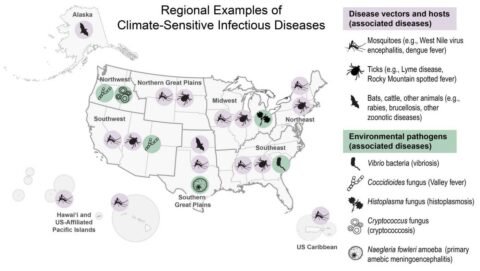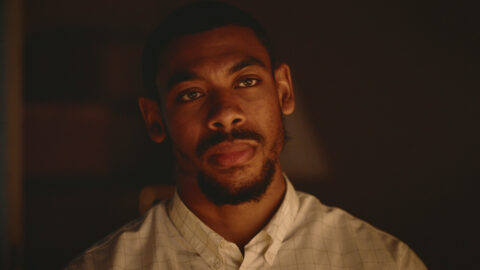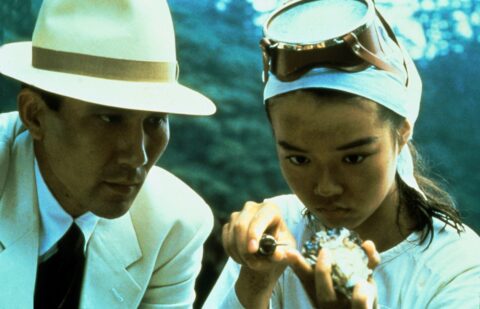Machine learning models are taking over in the field of weather forecasting, from a quick “how long will this rain last” to a 10-day outlook, all the way […]
5 facts from the latest U.S. climate report everyone should care about
The Biden administration just released the country’s biggest climate report since 2018, outlining the reality of climate change and just how complex its effects can be.
The best part of ‘Foe’ is how the world is ending
Garth Davis’ dystopian sci-fi thriller “Foe” shows the end of the world happening slowly but surely, thanks to climate change.

Garth Davis’ dystopian sci-fi, Foe, has been getting some lukewarm reviews. But there’s one surefire element of the film, based on Iain Reid’s 2018 novel, that actually deserves its moment in the burning, burning sun — and it’s not necessarily the beautiful people feeling all the feelings within it.
It’s the way the world as we’ve known it is actually ending, often incrementally but surely. And you’d better believe it’s all thanks to climate change.
How is the world ending in Foe?
Set in the year 2065, Foe is a work of speculative fiction that presents an Earth that has become almost but not entirely inhospitable, when fresh water and inhabitable land are scarce. They’re not human rights but instead the most important capital a human being can own. It’s Mad Max without the steampunk or gang violence.
Reid’s novel keeps specifics of the apocalypse off the page, but the film, which Reid and Davis co-wrote, gives details at the top. In this version of America, the government’s Federal Climate Alert System has become useless. Human displacement sits at the centre of the global climate crisis, with nations uprooted by extreme weather events. Air quality has declined and respiratory conditions have risen. People are encouraged to stay indoors to avoid the extreme heat. Folks live off-grid if they can, using solar panels and reusing their waste water, but it’s all a little too late. At the core of the narrative, humanoid AI robot substitutes have replaced human labour in many industries.
Quietly surviving on a barren, isolated Midwest property is married couple Hen and Junior, played by Saoirse Ronan and Paul Mescal. In this future, inhabitable land is mainly owned by companies or governments and used for farming; as for the rest, inheritance rules, as Junior’s property is fifth generation-owned. Above the dusty, cracked earth of the property, extreme weather events from intense dust storms to extreme heat are an everyday occurrence. Only one tree survives on the land, kept alive by the couple’s waste water. In fact, water is such a precious commodity that we regularly see Junior and Hen drinking cans of beer instead of water first thing in the morning — perhaps beyond mild hydration, beer doesn’t hurt for dealing with the end of the world, either. Though for someone trying to conserve water, Hen sure has some lengthy shower cries.

Credit: Amazon Studios
Foe shows the end of the world in an isolated, domestic silence for two people, but it’s also not quite ended. At every turn, it seems people are still working hard to keep surviving the harsh conditions. However, Junior and Hen’s quiet, rural life changes with the arrival of a man called Terrance (Aaron Pierre), who works for a government-backed company called OuterMore, wielding a plan to evacuate the planet — but notably slowly.
Plans to move people off-planet to a colossal space station near Earth are well underway, moving away from a “climate migration strategy” to simply getting the hell out of here. Terrance mentions that the moon, Mars, and other planets were possibilities built for the “first wave of temporary settlement”, but due to their distance from Earth and the time it will take to go back and forth to build a new colony there, OuterMore has instead built an enormous planet of its own near Earth and readies humans for permanent relocation to space through years of training.

Credit: Amazon Studios
People are chosen randomly through a lottery to participate in the first phase of the space program, known as The Installation, a two-year placement on the station to test its readiness for a whole planet to live on — but Terrance notes Junior’s physical strength as a positive attribute for it. Notably, the program isn’t optional for those chosen, instead functioning as a form of “fortunate conscription”. Through discussions of this station around Junior and Hen’s dining room table, Foe lightly takes aim at the billionaire space race and billion-dollar plans to terraform other planets like Mars. “Why should you be spending money up there when you should be fixing things down here?” Hen asks.
Hollywood disaster films love to cut to the chase.
By no means is Foe the only film to predict the end of the world through climate change and eventual human relocation to space — even in recent years, we’ve seen the likes of 2016 sci-fi Passengers sharing similar scenarios. But it’s something films have only started to really hammer home within the last few decades, with a notable rise in the 2000s. Though scientists had been warning of the coming threat for frustrating decades, and weather disaster films had long rampaged through cinemas, filmmakers finally seemed to harness these legitimate fears in the 2000s and 2010s, punishing earthlings’ blatant disregard for the planet with brutal, extreme weather-driven consequences in films like The Day After Tomorrow, Geostorm, 2012, and the Keanu Reeves remake of The Day the Earth Stood Still.
Not simply allowing viruses and sentient machines to destroy the world as we know it, rising sea levels caused by a warming planet finally got their moment in the 2000s, notably with Steven Spielberg’s 2001 film A.I. Artificial Intelligence — also aligned with Foe in terms of AI human replacements and self-aware robots in the coming apocalypse. In the film, set in the 22nd century, melting Arctic ice causes catastrophic flooding in coastal cities, meaning widespread human displacement, starvation, and death. New York is underwater. The global population plummets and humanoid robots step in for both human labour and companionship because they’re “never hungry and … did not consume resources beyond those of their first manufacture.”
In the book Hollywood Wants to Kill You, Rick Edwards and Dr. Michael Brooks write of Hollywood’s tendency to speed things up when it comes to planetary death by climate change, to get to the dramatically perilous stuff overnight instead of showing how it happens and how we could have stopped it gradually. The authors particularly skewer the films Geostorm and The Day After Tomorrow, which predict an overnight climate overhaul, a catastrophic tipping point that sees the planet plunged into every kind of extreme weather Hollywood can conjure at once.
“It turns out that governments, both Hollywood-imagined and real-life, aren’t really interested in long-term gains that involve short-term pain,” Edwards and Brooks write. The film 2012 also does this, cutting straight to the chase, but at least the movie consistently reiterates that scientists and world leaders have known what’s coming for years.
But one of the most realistic parts of the potential end of the world in Foe is not that we’ll all inevitably shack up with a smokin’ partner with an endless supply of PBRs. It’s that some things will happen slowly, the decline of the planet’s habitable spaces slowly increasing as CO2 levels skyrocket, climate science misinformation continues, and government inaction prevails. (Some impacts, like amplified Western U.S. wildfires and increased flooding, are happening rapidly.)
Foe isn’t a perfect representation of a future Earth, notably being the experience of two sad yet socioeconomically advantaged white people, citizens who by no means are on the frontline of the climate crisis. And notably, climate doomism itself gets us nowhere — we’re not completely up the bone dry creek yet. Despite how things appear, we haven’t passed a point of no return, and earthlings still have the power to either exacerbate the planet’s problems or seal them in stone.
Instead, Foe is a cautionary tale, a hypothetical endgame. One that’s slow but sure, and without action on climate change, could very well be what the end of the Earth looks like.
How to watch: Foe is now in theaters and will be streaming on Prime Video at a later date.
10 underappreciated movies you haven’t seen on Max
From “Princess Mononoke” to “Shiva Baby,” here are the best hidden gems on Max you need for your next movie night.

The Max catalogue is deep. Seriously deep. Deep enough to drown in, if humans could drown in movies. Luckily, we can’t. We can only watch them! Ain’t life fun! But before you open up the massive Max library and faint from decision paralysis, take a breath. We’ve got you. And we know what you’re looking for.
You don’t need help picking a big blockbuster for a rewatch — you’re in the mood for a hidden gem. A diamond in the rough. A movie you can recommend to your friends, and they won’t go, “Yeah, Carl, we all know you like Aquaman. Enough already.” These are the under-the-radar winners, the ones with smaller budgets, the foreign hits, or the ones that simply had abysmal marketing campaigns. Each makes for a pleasant surprise and a solid pick on movie night on Max.
1. Princess Mononoke

Credit: Dentsu / NTV / Studio Ghibli / Kobal / Shutterstock
When you think of Hayao Miyazaki and Studio Ghibli, you probably think of Spirited Away or My Neighbor Totoro. But Miyazaki has been telling visually stunning stories for decades, and since almost all of his works are now streaming on Max, it’s time to dive a little deeper into the Ghibli catalogue. Start with Princess Mononoke, the story of a leader determined to protect her lands from human consumption. Though she may align ideologically with Pocahontas, Princess Mononoke is far more ruthless, stopping at nothing to defend her fantastical home. Caught in the middle of this fight is a young prince, Ashitaka, hoping to help both sides achieve peace before a demon’s curse kills him.
Mononoke has all the markings of a Ghibli classic — wood spirits, gorgeous animation, ruminative landscapes — but boasts a more adult tone than many of Miyazaki’s other pieces. There is blood and war and pain in this whimsical world, and the story is more complex and engaging because of it. For an added treat, the script for the English dub was written by sci fi/fantasy legend Neil Gaiman, so you can watch the English version confident nothing is lost in translation.
How to watch: Princess Mononoke is now streaming on Max.
2. Everything Is Copy
Everything Is Copy is the best kind of love letter: one that’s effusive in its admiration of its subject, but also clear-eyed about her quirks and imperfections. Journalist Jacob Bernstein explores the life, career, and 2012 death of Nora Ephron — known to us as the writer and filmmaker behind such hit rom-coms as Sleepless in Seattle, You’ve Got Mail, and Julie & Julia, and to Bernstein as his mother.
Interviews with family members and famous friends (including Tom Hanks, Meg Ryan, and Mike Nichols), along with archival interviews and excerpts from Ephron’s own work, paint a portrait of a brilliant and ambitious spirit who lived by the motto stated in the title: “Everything is copy,” meaning everything that happens in life can be fodder for a story later on. Though you wouldn’t mistake Bernstein’s documentary for a work by Ephron herself, the film’s warmth, candor, and humor make it a fitting tribute to the icon she was.* — Angie Han, Deputy Entertainment Editor
How to watch: Everything Is Copy is now streaming on Max.
3. Au revoir les enfants
You’re about to be able to impress film snobs at parties. Au revoir les enfants is a gorgeous and startling film about friendship, and one of the most respected movies in cinema history. Famed French filmmaker Louis Malle wrote, directed, and produced this autobiographical film about his childhood in Nazi-occupied France. The main character Julien, based on Malle himself, is a young student at a boarding school who discovers the headmaster is sheltering three Jewish boys among the student population. Julien forms a bond with one of the boys, Jean Bonnet, and the two navigate an increasingly dangerous world. Au revoir les enfants is a WWII film without any battles. We are confined to the limited landscape of the boarding school and its surrounding town, yet the horrors of war are ever present. It is both subtle and deeply moving, and it will stick with you long after viewing.
How to watch: Au Revoir les Enfants is now streaming on Max.
4. Time Bandits
If you remember Time Bandits, then we are happy for you, for you truly know the meaning of joy. This insane and amazing fantasy, written by Monty Python veterans Terry Gilliam and Michael Palin, is a one-of-a-kind adventure. Eleven-year-old Kevin is asleep in his bedroom when a man on horseback bursts out of his wardrobe and rides off into a forest that disappears behind him. The following night, five small bandits tumble out of the wardrobe and take Kevin on an adventure through history, stopping by the Napoleonic Wars, Ancient Greece, and even the Titanic. John Cleese, Sean Connery, Shelley Duvall, and Ian Holm sparkle as their historical counterparts, adding wit and gravitas to the whimsical plot. This is a film that needs to be seen to be believed — but once seen, it will quickly be beloved.
How to watch: Time Bandits is now streaming on Max.
5. Those Who Wish Me Dead

Credit: Emerson Miller
It’s a safe bet that you haven’t seen Those Who Wish Me Dead, because almost no one did. A June 2021 debut (a very hesitant time for moviegoers) and a rushed marketing campaign earned this Angelina Jolie-led thriller the honor of being the second-worst opening of all time for a film in more than 3,000 theaters. But don’t let that sway you. This exhilarating, and somewhat insane, movie is a propulsive 100 minutes of action and suspense against the most lethal backdrop of all — the wildfires of the American West. Jolie stars as Hannah, a veteran forest firefighter spending the summer in an isolated, Montana firewatch tower, trying to get her head right after the tragedies of the previous year’s fire season. Suddenly, she finds herself in a very different film, as her path crosses with a child being chased by a pair of assassins (Nicholas Hoult and Aidan Gillen), and she’s the only adult who can protect him. The human elements of the film are comically light in explanation and backstory, but that forces us to focus our fear on the true and ultimate threat here: an unforgiving wall of fire.
How to watch: Those Who Wish Me Dead is now streaming on Max.
6. 61*
This critically acclaimed sports drama (directed by Billy Crystal!) flew under the radar because it was made for HBO in 2001 — a time when TV movies were not as respected as their silver-screen counterparts. However, 61* is just as riveting and affecting as any bigger-budget sports flick, if not more so. This is both the story of Mickey Mantle and Roger Maris attempting to break Babe Ruth’s home run record in 1961 and of an unlikely friendship. The charismatic, partying Mantle and the reserved, quiet Maris make for an unusual pair, with each Yankee earning different treatment from the press while the pressure of the season takes its toll. Led adeptly by Thomas Jane and Berry Pepper, 61* is a winning film in any year.
How to watch: 61* is now streaming on Max.
7. The Normal Heart
Directed by Ryan Murphy, The Normal Heart is a searing emotional drama that lacks the signature camp of most Murphy vehicles — and here, that’s a good thing. Adapted by Larry Kramer from his play, Heart follows Mark Ruffalo as Ned Weeks, an openly gay writer in the ’80s who watches the growing HIV/AIDS crisis ravage his community. What sets The Normal Heart apart from other movies on the same topic is its intimacy. We witness the crisis through Ned’s eyes as his friends, neighbors, and lovers are ripped from him. Ned visits hospitals, writes stories, and fights tirelessly with the help of Dr. Emma Brookner (Julia Roberts) to bring more attention and funds to the cause, only to be met with bigotry and silence. A strong and deeply charismatic supporting cast (Matt Bomer, Taylor Kitsch, Jim Parsons, Alfred Molina, Joe Mantello, and Jonathan Groff) will make you fall in love with them, before breaking your heart. Do not be intimidated: This is a film that will leave you feeling cleaved in two, but it also imparts a quiet, warm optimism. A rare combination.
How to watch: The Normal Heart is now streaming on Max.
8. Shiva Baby
Worlds collide in this 2020 cringe comedy that’s been widely hailed by critics. When a Jewish college student (Rachel Sennott) dutifully attends a shiva alongside her parents, she’s prepared to field questions about her unimpressive job prospects and lack of a boyfriend. However, she’s not ready for her secret sugar daddy (Danny Deferrari) to show up, much less with his beautiful blonde wife (Dianna Agron) and their rosy-cheeked baby. Making matters even more fraught, her former best friend is slinging her serious side-eye. Something has got to give. In her remarkable debut feature, writer/director Emma Seligman creates laughs and suspense with an electrifying tapestry of observational humor, social awkwardness, jolting humiliation, and sexual tension. You’ve heard of feel-good comedies? Well, this is a feel-anxious-as-hell comedy, dragging us through each embarrassment with our harried heroine. And yet, we can’t recommend the experience highly enough.* — Kristy Puchko, Film Editor
How to watch: Shiva Baby is now streaming on Max.
9. Tampopo

Credit: Apic / Getty Images
A spirited spoof tipping its hat to the Spaghetti Western, this 1985 Japanese comedy was promoted as a “ramen Western.” Its central story is about a cowboy hat-wearing truck driver (Tsutomu Yamazaki), who comes across a humble ramen shop where the food is truly “terrible.” Damsel in distress Tampopo (Nobuko Miyamoto) begs this hardened hero to save her family’s business by teaching her to do right by ramen. So of course, he rounds up a posse to perfect her recipe. Full of physical comedy, giddy silliness, quirky characters, and charming performances, this film is a delectable delight. But writer/director Jûzô Itami brings even more to the table, spicing up this culinary tale with fantastical vignettes about the love of food. Though often ridiculous — and sometimes salacious — none of the laughs are lost in translation. But be warned: This funny film will make you hungry. The loving shots of ramen and the various speeches about its richness and wonders are ruthlessly mouth-watering. Maybe order dinner before digging in.* — K.P.
How to watch: Tampopo is now streaming on Max.
10. Johnny Dangerously
In the 1980s, Micheal Keaton was a mega-star, headlining comedies like Mr. Mom and Beetlejuice as well as Batman. Too often forgotten in this hot streak of ’80s movies was Amy Heckerling’s mafia parody Johnny Dangerously. In this 1930-set comedy, Keaton stars as the eponymous gangster, who has a smoking hot lounge singer for a wife (Marilu Henner), a snarling gun-slinger for a nemesis (Joe Piscopo), and a straight-as-an-arrow district attorney for a brother (Griffin Dunne). Full of slapstick, outrageous jokes, and some punchlines that’d make your granddad blush, Johnny Dangerously is a laugh riot. And stay through the credits for a theme song from Weird Al Yankovic. — K.P.
How to watch: Johnny Dangerously is now streaming on Max.

Opens in a new window
* denotes that the writeup comes from a previous Mashable list.
UPDATE: Oct. 25, 2023, 3:20 p.m. EDT This article has been updated to reflect the latest streaming options.
Overstory snags $14M Series A to use AI to help utilities cut their wildfire risk
First it was California, which experienced year after year of deadly wildfires. Then came Hawaii’s deadly firestorm this year. Camp, Dixie and Lahaina aren’t just three of the […]




